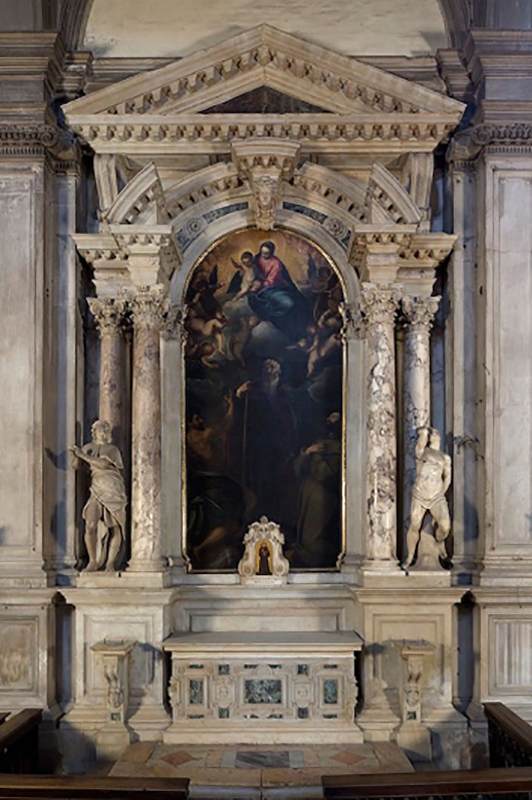Italian sculptor and architect, son of a tailor in Trent. After apprenticing to sculptors in his hometown, in 1543 Vittoria moved to Venice, where he lived, with only two interruptions, for the rest of his life. There he entered the workshop of Jacopo Sansovino and continued to work for Sansovino during the 1540s. By 1550 he was an independent master. His earliest known sculpture, the marble statuette of St John the Baptist (San Zaccaria, Venice, right-hand stoop), dates from 1543.
Following a quarrel with Sansovino, Vittoria began working outside Venice, in the cities of Trent and Vicenza (1551-53). His main project in Vicenza was the stucco decoration of rooms in Andrea Palladio's Palazzo Thiene (now Banca Popolare), where the ceilings chart the development of his decorative idiom.
As a result of Pietro Aretino's mediation Vittoria was reconciled with Sansovino, and by May of 1553 he was back in Venice. The two large caryatids known as the Feminone (1553–55), at the entrance to the Libreria Sansoviniana, were Vittoria's first essay in large-scale stone sculpture. As Sansovino's closest collaborator during the 1550s, he worked on a number of projects in Venice that were headed by Sansovino, including the stuccos (1556; 1559–60) over the monumental staircase of the Libreria Sansoviniana and those (1557–9) over the Scala d'Oro in the Doge's Palace. These sumptuous decorations further extend the principles applied in the Palazzo Thiene: the vaults over the staircases are treated as sculpture, with the result that the frescoes are overwhelmed by the massive stuccos surrounding them.
The 1560s marked the start of the period during which Vittoria reached full artistic maturity. In November 1561 he was commissioned to work on the altar in the Montefeltro Chapel, San Francesco della Vigna, Venice. Carved of Rovigo stone, the statues of St Anthony Abbot, St Sebastian and St Roch (completed by 1564) show him in full command as a sculptor of life-size figures. Other projects of this decade include - among others - the two marble caryatids, eventually placed on Vittoria's tomb in San Zaccaria, Venice; a marble bust of Priamo da Lezze, placed on the family monument in Santa Maria Assunta dei Gesuiti, Venice, in the 1580s; and a marble bust of Niccolò Massa (Venice, Ateneo Veneto) for San Domenico di Castello, Venice.
Vittoria's most ambitious undertaking of the 1560s, however, was the altar of the Zane Family in Santa Maria Gloriosa dei Frari, Venice. The altar was dismantled in the mid-18th century by the monks of the Frari, and only the architectural frame of the altar, two angels on top of the pediment, two of the stucco figures and the centrepiece of the work, a marble, over life-size St Jerome, survive.
During 1574 Vittoria worked on the four great stucco Evangelists set into the inner façade of San Giorgio Maggiore, Venice, which was designed by Palladio. These statues formed the earliest component of the decoration of the church, and their spiralling, ecstatic rhythms show the increased expressiveness and poetic quality of Vittoria's figural language at this time. During the 1570s he supervised the decoration of the Chapel of Our Lady of the Rosary in Santi Giovanni e Paolo, Venice. It was during the 1570s that Vittoria brought his portrait style close to perfection. The busts of Tommaso Rangone (Vittoria's only bronze bust), Ottaviano Grimani and Sebastiano Venier were produced in this period.
In 1576 Vittoria was at work on the altar for the Scuola di San Fantin (now the Ateneo Veneto), Venice, the major element of which was the marble St Jerome (now Santi Giovanni e Paolo, Venice). This later St Jerome reveals an increasing pathos in Vittoria's work, as well as a change in his sculptural technique to a less detailed, more astringent manner.
From the early 1580s onwards Vittoria left more and more tasks to his workshop. Nonetheless Vittoria produced some of his greatest works during the 1580s. Probably in the first half of the decade, he supplied bronzes of the Virgin and St John of a Crucifixion in Santi Giovanni e Paolo, Venice. The terracotta bust of Doge Nicolò da Ponte (Pinacoteca Manfrediniana, Venice), perhaps Vittoria's greatest portrait, was made around 1584. However, after 1585, the autograph production of portrait busts declined sharply. The so-called Pala Fugger (early 1580s; Art Institute, Chicago), a bronze relief of the Annunciation made for Johann Fugger, a member of the famous German banking family, was inspired by Titian's painting of the same subject.
Vittoria's bronze statuettes, although an important aspect of his output, have never been thoroughly studied, with the result that basic problems of attribution and chronology persist. They include some of his most beautiful works and demonstrate how medium affects aesthetic: unlike the marble statues, which tend to command only one main viewpoint and which always reflect the shape of the original block of stone, the bronzes are more overtly three-dimensional. Characteristic examples are St John the Baptist (San Francesco della Vigna, Venice) and St Sebastian (Metropolitan Museum of Art, New York).
Although the altar Vittoria designed for the Scuola dei Luganegheri (the guild of sausage-makers) in San Salvador is usually dated to 1600, it more likely dates from c. 1590. The figure of St Sebastian in the altar, writhing in pain against the column behind him, is one of the most moving in all Venetian sculpture.
Vittoria is known for medals, and he was also an architect and painter, but little is known of his work in these media.
From 1602 to 1605 Vittoria oversaw the work on his tomb monument in San Zaccaria, Venice, which was largely carried out by his nephews Vigilio Rubini and Andrea dell'Aquila, to whom he bequeathed his drawings, models and tools. He died at Venice on 27 May 1608.
//
![]()









